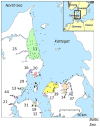Species Sorting of Benthic Invertebrates in a Salinity Gradient - Importance of Dispersal Limitation
- PMID: 28006014
- PMCID: PMC5179068
- DOI: 10.1371/journal.pone.0168908
Species Sorting of Benthic Invertebrates in a Salinity Gradient - Importance of Dispersal Limitation
Abstract
The relative importance of environment and dispersal related processes for community assembly has attracted great interest over recent decades, but few empirical studies from the marine/estuarine realm have examined the possible effects of these two types of factors in the same system. Importance of these processes was investigated in a hypothetical metacommunity of benthic invertebrates in 16 micro-tidal estuaries connected to the same open sea area. The estuaries differed in size and connectivity to the open sea and represented a salinity gradient across the estuaries. The Elements of Metacommunity Structure (EMS) approach on estuary scale was complemented with a mechanistic variance partitioning approach on sample scale to disentangle effects of factors affecting assembly of three trait groups of species with different dispersivity. A quasi-Clementsian pattern was observed for all three traits, a likely response to some latent gradient. The primary axis in the pattern was most strongly related to gradients in estuary salinity and estuary entrance width and correlation with richness indicated nestedness only in the matrix of the most dispersive trait group. In the variance partitioning approach measures of turnover and nestedness between paired samples each from different estuaries were related to environmental distance in different gradients. Distance between estuaries was unimportant suggesting importance of factors characterizing the estuaries. While the high dispersive species mainly were sorted in the salinity gradient, apparently according to their tolerance ranges towards salinity, the two less dispersive traits were additionally affected by estuary entrance width and possibly also area. The results exemplify a mechanism of community assembly in the marine realm where the niche factor salinity in conjunction with differential dispersal structure invertebrates in a metacommunity of connected estuaries, and support the idea that dispersive species are more controlled by the environment than less dispersive species.
Conflict of interest statement
The author has declared that no competing interests exist.
Figures







References
-
- Baselga A. Partitioning the turnover and nestedness components of beta diversity. Global Ecol Biogeogr. 2010; 19: 134–143.
-
- Pulliam RH. On the relationship between niche and distribution. Ecol Lett. 2000; 3: 349–361.
-
- Leibold MA, Holyoak M, Mouquet N, Amasekare P, Chase JM, Hoopes MF, et al. The metacommunity concept: a framework for multi-scale community ecology. Ecol Lett. 2004; 7: 601–613.
-
- Hendrickx F, Maelfait J-P, Desender K, Aviron S, Bailey D, Diekotter T, et al. Pervasive effects of dispersal limitation on within- and among-community species richness in agricultural landscapes. Global Ecol Biogeogr. 2009; 18: 607–616.
MeSH terms
LinkOut - more resources
Full Text Sources
Other Literature Sources

